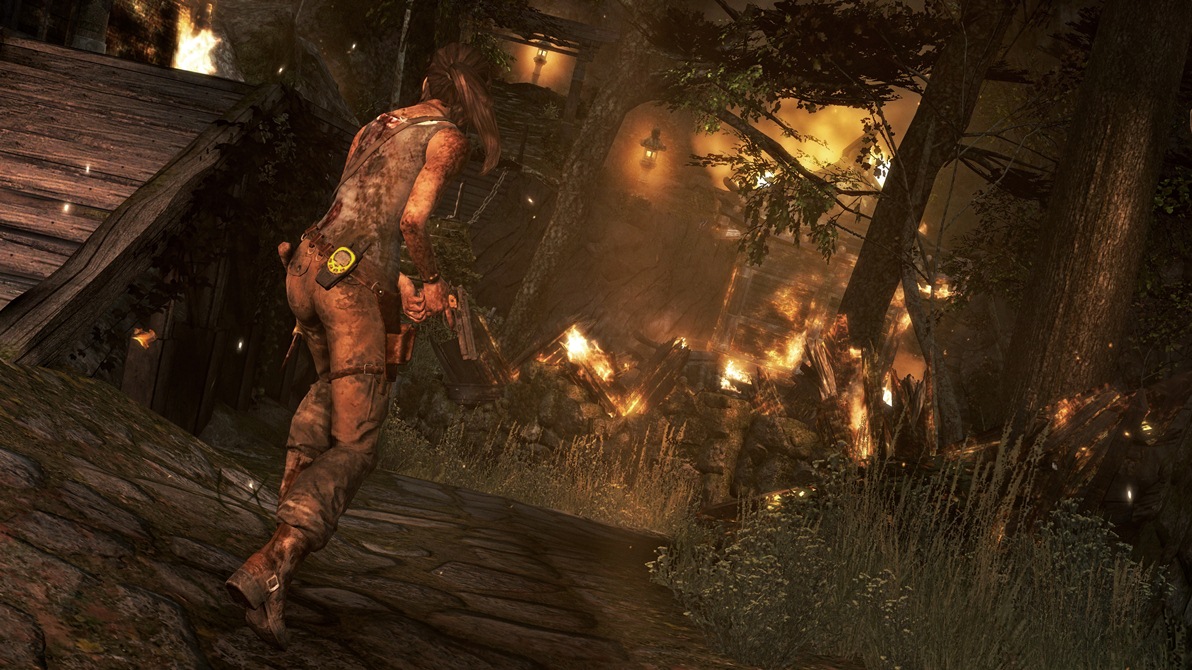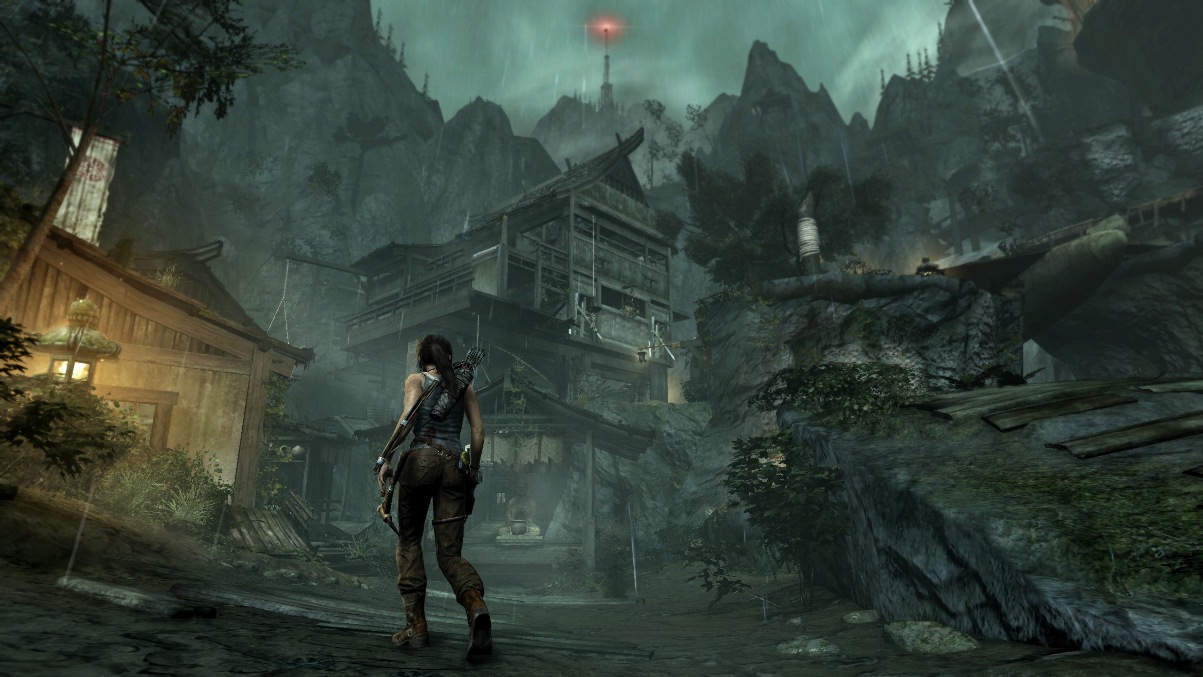
Today i want to share a great game that name is Tomb Raider Pc Review.
Tomb Raider is an Indiana Jones-style action-adventure series, based on the exploits of fictional British archaeologist Lara Croft. The latest entry in the series is a ‘reboot’: a retooling of Croft’s origin story and character to sit better with modern audiences.Tomb Raider's action-adventure series, based on the exploits of fictional British archaeologist Lara Croft, began in 1996. Croft has since cemented her position as one of video gaming’s best known protagonists.
The franchise was never known for the character development or depth of storytelling that modern games of the genre aspire to. Croft’s most recognised character traits have always been her figure and her propensity for murder, with her archaeological talent easy to forget.

The rebooted Tomb Raider
begins with a young Lara Croft on an expedition to locate a lost
Japanese kingdom – once island home to the fabled ‘Sun Queen’ Himiko.
Unlike the majority of modern games, which begin with a helicopter
crash, Tomb Raider shakes things up with a good old-fashioned shipwreck,
leaving Croft and her crew stranded on the island they were looking
for. Thus begins a storyline that wavers between an Indiana Jones plot
and that of Lost, though fortunately without the gargantuan plotholes of
the latter.

Owners of AMD visual craftmanship cards can turn on the brand-new ‘TressFX’ feature, which does for hair what tessellation did for rounded surfaces allowing hair to evolve beyond ‘bundle of dry spaghetti’. it may feel like it's trivial, but seeing individual strands of hair waving in the wind is jaw-dropping.
Though it’s AMD-built up technology, TressFX should work on Nvidia cards. In my case, it caused a 50% reduction in framerate that made the game nausea-inducing. Many Nvidia-owners have reported trouble running the game with TressFX enabled, some not able to even reach the menu screen. it's brilliant if it works, and disappointing but easily switched off it it doesn’t. Honestly, the digital physical looks are so gorgeous overall, that TressFX is just the cherry on top.
While you’re marvelling at
the digital physical looks, the young, fresh-faced and innocent Croft
is being kidnapped, set alight, impaled, and almost killed – all in the
first few minutes of the game. It’s all very visceral and ‘realistic’,
apart from Croft’s ability to soak up huge amounts of damage and keep on
going. I’m open to the idea of suspend disbelief when gaming, but some
of the falls she takes make it seem like her tank top is made of kevlar
and possesses the ability to knit broken bones and dispense morphine.
perhaps she’s related to the protagonist of Far Cry, whose mighty
hawaiian shirt possessed similar death-resistant properties.

Combat is
smooth and enjoyable, if not particularly challenging on ‘Normal’
difficulty. I used the bow for almost the entire game: its silent firing
allows for a certain amount of stealth. Pistols, shotguns and assault
rifles make for quick work of enemies, particularly considering most are
only armed with bows themselves, but lead to big messy firefights.
often that’s an inevitable outcome whatever approach you take, and
you’re forced into cover-based combat. Tomb Raider’s approach to cover
is commendable – Croft automatically takes cover when pushed up against a
wall or suitable obstacle, and will fire around or over it in a
realistic fashion.
One thing that did irritate me was the lack of a ‘crouch’
function – Croft automatically crouches when the game thinks you has to
be stealthy, and stands when it doesn’t. As I go for the stealthy option
whenever one is available, the lack of manual control was highly
irritating. This is symptomatic of the game’s one most powerful flaw:
Tomb Raider doesn’t so much hold your hand as handcuff itself to you and
drag you along by the wrist.
There are some wonderful wide-open environments to explore,
which give the island a real sense of scale. However, the game makes
heavy use of scripted sequences and quicktime events (press F to not
die). it's very cinematic and allows for some very well-designed
climbing, running and falling sequences that provide more interactivity
than a simple cutscene. However, those used to having control at all
times are guarenteed to find it frustrating.
sometimes
backtracking is required if you really need to collect all of those
optional doohickeys, as you might not be able to access an item in Area A
until you’ve found some new equipment in Area B or C. It adds a touch
of replayability without having to play the whole game again. Having
said that, the only reward in finding all those collectables is
experience points you don’t need once you’ve finished the game, and
unlocking concept art in the main menu.
Many side-challenges made me raise an eyebrow in retrospect –
they involved standard ‘video game challenge’ objectives such as
shooting bone carvings out of trees, or burning historical posters
around World War II installations. Thinking about it later, though, this
seems an amazingly odd thing for an archaeologist to be doing for no
apparent reason. Burn precious pieces of history for a laugh? Sure, that
sounds great. There’s a slight disconnect between gameplay and story in
that regard, just as Croft makes an almost jarringly fast transition
from ‘innocent victim’ to ‘slay all the people’.

So, it’s not perfect.
Tomb Raider holds your hand a little too much for the sake of story,
but then sacrifices story for the sake of incongruous challenges.
Somewhere in that mess of minor mistakes it strikes a balance, and
secures a place among the most desireble games I’ve ever played. Not
only is 2013’s Tomb Raider well worth your time, but it bodes well for
the games to come in the ‘rebooted’ franchise.
Video Watch Youtube
https://www.youtube.com/watch?v=IBU_Ph8uVMU&feature=player_embedded&noredirect=1

Post a Comment